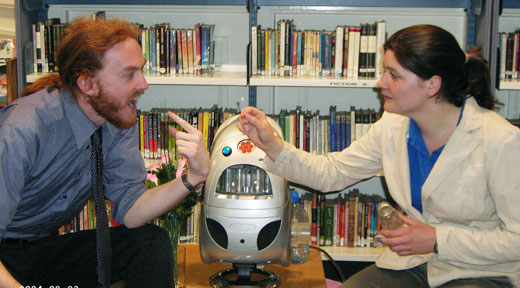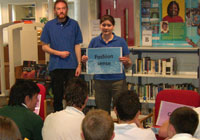Meet the Gene Machine: stimulating bioethical discussions at school Teach article
Laura Strieth, Karen Bultitude, Frank Burnet and Clare Wilkinson use drama and debate to encourage young people to discuss genetics and what it means for us all. Why not join in?
Genetics: a difficult subject
Genetic technologies have advanced dramatically since Watson and Crick first announced the structure of DNA 55 years ago. But these advances – including an increase in the number of genetic tests to diagnose or predict disease, the growth of gene banksw1 and advances in reproductive technologies – have raised complex personal, social and ethical questions. Who should have access to a person’s genetic profile and how should it be used? How does personal genetic information affect our perception of ourselves and others? Who owns and controls genetic data? How are minority communities affected by genetic information? These are just some of the questions that audiences (aged 13-18) are encouraged to think about and discuss during a ‘Meet the Gene Machine’ event, and which you can employ in your own classroom.
The activity concentrates on discussion and debate – encouraging the students to think critically about the impact that science has on their lives and on society. These skills are central to the science courses recently introduced in England and Walesw3 (Burden, 2007; Millar, 2006), and school students themselves have been shown to value themw4.
Meet the Gene Machine was devised by the Science Communication Unitw5 at the University of the West of Englandw6, Bristol, and is funded by the Wellcome Trustw7. The project and the training materials were developed with the advice of a genetic counsellor, scientists, a teacher and a playwright. The activity has been tested across the UK and internationally.
The format is transferable and easy to perform: it has been used successfully by university students, science centre and museum staff, actors and secondary-school students. It is particularly appropriate for students aged 13-18 but could also be used with other age groups.
Try it in your own classroom
Meet the Gene Machine opens with a short play to inform and amuse young people: a scientist explains his newly developed gene machine during a television chat show. The play stimulates an informed and lively debate by introducing pupils to basic genetics and raising vital ethical and social questions about modern and future genetic technologies.
Host: … What do you call that thing?
Chris: Oh, the Microarray and Microassay Hyper Channel Optimising Genetic Analysis with Real Time Interpretive Functionality Unit.
Host: OK… the Gene Machine. And what does it do?
Chris: I take a sample of DNA, insert it in here and the Microarray and…
Host: Gene Machine.
Chris: …and the Gene Machine analyses it and prints out a complete genetic profile.
The script for the play can be freely downloadedw2 for use in the classroom and may be performed either by two teachers or by two pupils. The only essential props are a cotton bud and a fictional gene machine, which can be designed in accordance with the teacher’s or students’ imagination.

Communication Unit
Chris: Ah, now that’s a really interesting gene.
Host: Uh huh.
Chris: Well, it’s pretty technical. You might want to talk to a few people about that…
Host: Yes?
Chris: (DEEP BREATH) That gene suggests you have a predisposition towards breast cancer.
Following the play, there is a structured discussion, during which students can express their own opinions and consider the opinions of their peers on matters of genetic testing. To enable teachers running the activity to involve as many students as possible in the discussion, the Meet the Gene Machine team have developed some ideas and games suitable for a range of settings. Below are two of the most successful techniques.
The ranking game
Ask the audience to grade an array of characteristics (such as hair colour or criminality) on a spectrum between ‘very genetic’ and ‘not genetic at all’. Not only do students react enthusiastically to this game, but it enables the teacher to clarify the basic science and draw attention to uncertainties in the field of genetics.
Resources required
1) Print a selection of genetic and non-genetic characteristics (see examples below) on laminated A4 or preferably A3 paper. The students should discuss to what extent each characteristic is genetically determined.
Ranking game characteristics:
Musical ability
Cystic fibrosis
Alcoholism
Hair colour
Athleticism
Intelligence
Bowel cancer
Huntington’s disease
Sickle cell anaemia
Schizophrenia
Criminality
Homosexuality
Bad breath
Eye colour
Short hair
2) A sign reading ‘very genetic’ and another reading ‘not genetic at all’ should be positioned at opposite ends of the classroom. During the discussion, the students should pin the laminated paper for each characteristic on the wall at the appropriate point on the spectrum between these two signs.
Tips

Communication Unit
To keep the class interested, we recommend that you run the ranking game for no more than four or five characteristics. You could either select characteristics that have been considered in previous lessons or introduce a fresh topic to students.
For the first characteristic, you could ask your pupils to each stand on the spectrum according to how genetic (or not) they believe the feature to be. This way you can get them moving and talking to each other right from the start.
For many characteristics, there is no known right or wrong answer; it is important to emphasise this, as it will encourage the students to share their opinions. This uncertainty in the field of genetics is what makes it possible to have an open discussion and for the activity to be updated with new developments as they occur.
For information on current genetic news and technologies, visit the Science Communication Unit websitew4. Here, you can find an archive of our monthly newsletter, produced during the UK rollout of the Meet the Gene Machine project, which contains information on genetics. The newsletter is freely downloadable.
Disclosure
In this activity, the audience explores issues of confidentiality, ownership of information, consent to the information being shared and the wider implications of genetic testing.
Split the audience into groups and ask them to discuss whom they ‘would really tell’ details of their genetic information to and whom they ‘would really not tell’.
Resources required
Print A4 or preferable A3 laminated cards with any of the options below. In a classroom of 30 pupils, we suggest you use a total of 24 cards, but this depends on whether you decide to run the activity in small groups or with the whole class.
Family
Doctor
Insurance company
Employer
School
Police
Friends
Tips
Try splitting your class into groups of five and giving each group four cards to talk about. You can decide which combination of four cards each group receives.
Within their groups, the students should discuss whom they would be happy to divulge their genetic information to, whom they would prefer not to tell, and why. At the end of the activity, a spokesperson from each group should share with the class the points that were raised during their discussion. Groups do not need to reach a consensus but they should explain their reasons for divulging the information to some groups and not to others.
More activities for the classroom
The Meet the Gene Machine team has designed further teachers’ resources to facilitate discussions of bioethics in the classroom. The material is easy to use with lesson plans and suggested resources, for example handouts to produce, to run the activity in the classroom. It is freely available online in Word formatw2.
For advice on using the resource materials, contact the Science Communication Unit (science.communication@uwe.ac.uk).
International transferability
Meet the Gene Machine was originally delivered by the UK team as part of Czech Science Week in 2003, and has since been performed successfully in many other countries, including Italy, Portugal, Latvia, Costa Rica and Hong Kong. The format is easily transferable, requires few specialist props or theatre effects, and is easy to stage for various audience sizes and venue types. The materials and event format are currently designed for students aged 13-18, and the science is accessible to mixed-ability groups.
Feedback from the audience
‘The drama is humorous and informative, and you get to hear lots of different opinions during the discussion’ (14-year-old student)
‘The group discussion worked very well and makes you think about everyday issues’ (17-year-old student)
‘With an emphasis on developing scientific thinking, the Meet the Gene Machine materials provide a valuable opportunity for students to discuss different aspects of genetics. The resources support teachers to engage students through structured debate of contemporary issues. A number of useful strategies for group work are included, which can be successfully applied across several subject areas’(head of science)
References
- Burden J (2007) Twenty First Century Science: developing a new science curriculum. Science in School 5: 74-77. www.scienceinschool.org/2007/issue5/c21science
- Millar R (2006) Twenty First Century Science: insights from the design and implementation of a scientific literacy approach in school science. International Journal of Science Education. 28: 1499-1521
Web References
- UK Biobank aims to study how the health of 500 000 people is affected by their lifestyle, environment and genes. The purpose of this major project is to improve the prevention, diagnosis and treatment of a wide range of illnesses and to promote health: www.ukbiobank.ac.uk
- To find out more about the Twenty First Century Science curriculum introduced in England and Wales, see: www.21stcenturyscience.org
- Student Review of the Science Curriculum: Major Findings, a project conducted as part of Science Year and published in 2003, is available at: www.planet-science.com/sciteach/review/Findings.pdf
- To learn more about the Science Communication Unit, see: www.science.uwe.ac.uk/sciencecommunication
- To find out more about the University of the West of England, see: www.uwe.ac.uk
- The Wellcome Trust is the world’s largest medical research charity funding research into human and animal health. To find out more, see: www.wellcome.ac.uk
Review
This article gives a brief description of a set of fairly simple, yet innovative activities that can be easily used in any science (especially biology) classroom to promote student interest, thinking and debate on important ethical issues about the application of genetic knowledge.
The article provides a sample of a large selection of teaching activities complete with instructions and lists of required materials; more activities are available on the Internet. The material is ready to use; the teacher has only to download it and – if necessary – translate it from English. Furthermore, motivated teachers can be inspired by the material to develop their own similar activities for use in other science subjects (protection of the environment versus economic development, and a comparison of the pros and cons of different energy sources could make interesting cases).
The article could be used as the basis of a debate or discussion about:
- What is included in a person’s genetic profile?
- Who should have access to a person’s genetic profile and how should it be used?
- How does personal genetic information affect our perception of ourselves and others?
- Who owns and controls genetic data?
- How are minority communities affected by genetic information?
- What is the impact of genetic knowledge on people’s lives and on society?
Additionally, the didactic material presented in the article (and on the related website) could be used as a model for developing similar material to investigate other ‘hot’ issues.
Michalis Hadjimarcou, Cyprus





